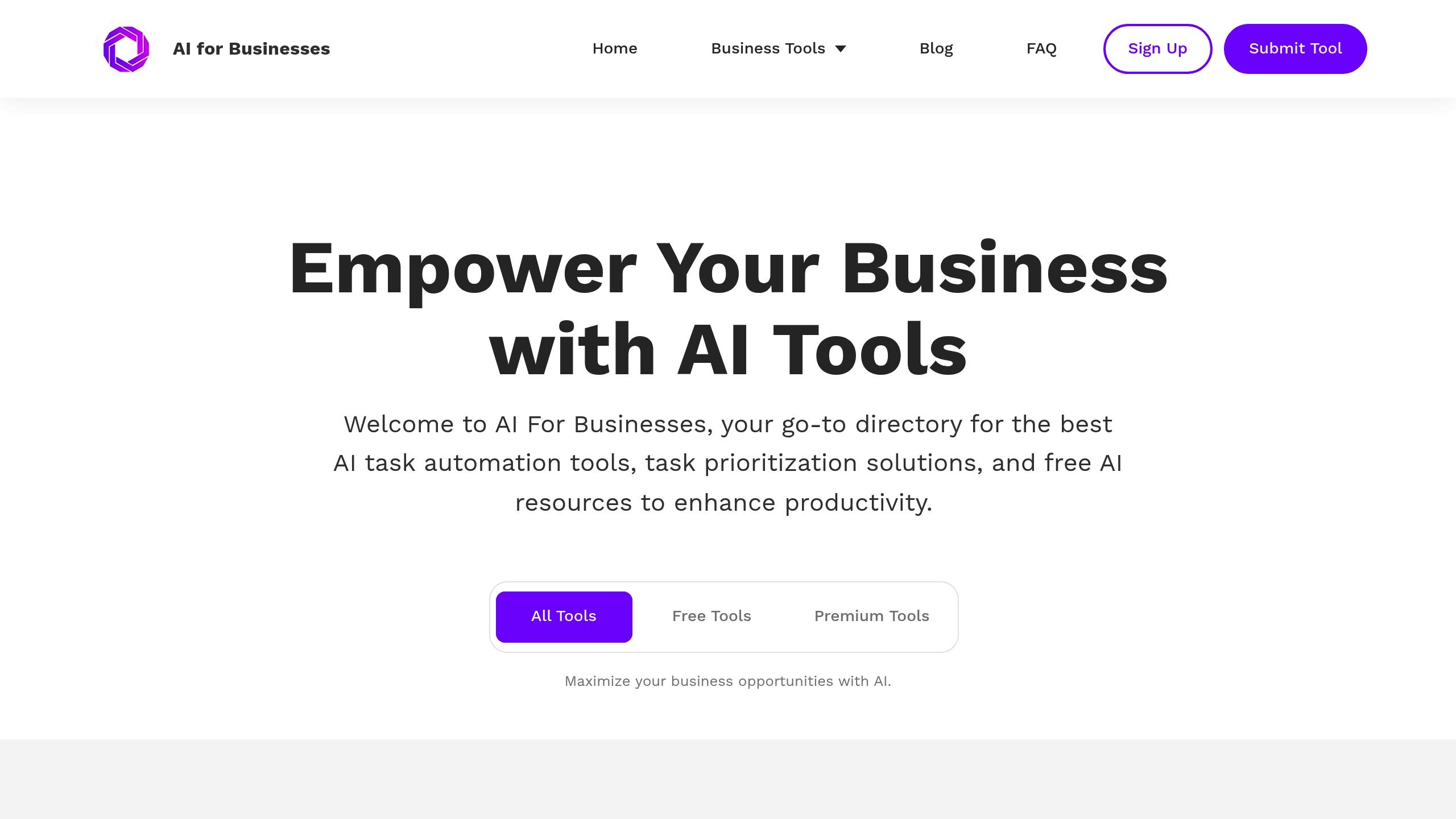AI is transforming how businesses address skill gaps, offering faster, more accurate, and cost-effective solutions. Here's what you need to know:
- Skill Gaps Impact: 87% of executives and 80% of small businesses report skill shortages, leading to reduced productivity, higher costs, and difficulty adopting new technologies.
- AI-Powered Tools: AI tools like IBM’s "Your Learning" platform boost training efficiency by 40%, reduce employee training time by 40%, and increase satisfaction by 25%.
- How It Works:
- Uses data (resumes, reviews, project records) to map skills.
- Predicts future skill needs by analyzing trends and job postings.
- Creates personalized, role-based learning paths.
- Benefits for SMEs: Affordable AI tools allow small businesses to cut assessment time by 90%, reduce training costs by 50%, and improve employee engagement by 40%.
Quick Comparison: Manual vs AI Skill Gap Analysis
| Aspect | Manual Analysis | AI-Powered Analysis |
|---|---|---|
| Processing Time | 3-4 months for 10,000 staff | 24 hours for 10,000 staff |
| Accuracy Rate | Assessor-dependent | 30% higher accuracy |
| Cost Structure | High labor costs | 40% lower long-term costs |
| Data Integration | Limited | Real-time updates |
AI makes skill gap analysis faster, smarter, and more accessible for businesses of all sizes.
AI and Talent Acquisition Strategies: Predictive Analytics and Skill Gap Analysis
How AI Analyzes Skill Gaps
AI identifies skill gaps by recognizing patterns across multiple workforce data sources.
AI Skill Mapping Process
AI-powered skill mapping pulls information from various channels, significantly speeding up the assessment process. Some organizations have reported up to a 90% reduction in assessment time[8].
| Data Source | Analysis Method | Outcome |
|---|---|---|
| Employee Resumes | Text Processing | Identifies and categorizes skills |
| Performance Reviews | Performance Metrics | Highlights demonstrated competencies |
| Project Records | Progress Tracking | Assesses practical skill application |
| Communication Data | Collaboration Pattern Tracking | Detects informal expertise |
| Training Records | Historical Performance Analysis | Evaluates learning effectiveness |
As team members complete projects or earn certifications, the system updates skill maps automatically. These updated maps help guide the personalized learning plans covered in the next section.
Using AI to Forecast Skill Needs
AI helps organizations prepare for future skill demands by aligning learning paths with changing role requirements. It uses advanced methods to predict skill needs, including:
- Analyzing competitor job postings
- Monitoring academic research
- Correlating market trends and changes
Creating Role-Based Learning Plans with AI
Once AI identifies skill gaps, organizations can implement focused learning strategies. This method, once limited to large enterprises, is now within reach for smaller businesses thanks to modern tools.
Personalizing Learning Content
Using skill maps derived from workforce data, AI tailors learning experiences by:
- Focusing on skill gaps highlighted during performance reviews
- Matching content formats to individual learning preferences
- Refreshing materials to keep up with changing role demands
According to a 2023 LinkedIn Learning study, personalized learning paths powered by AI increased employee engagement by 45%, with 60% of employees favoring this method over traditional training approaches [6].
Progress Tracking and Path Updates
AI keeps track of learning progress and fine-tunes training paths based on performance metrics. This approach addresses the 37% growth challenge cited by small businesses, resulting in a 30% boost in training effectiveness [6].
Adjustments are made by:
- Monitoring how many modules employees complete
- Reviewing assessment scores to measure understanding
- Observing how skills are applied in real-world tasks
- Collecting feedback from both learners and their managers
The system focuses on areas where employees struggle while incorporating new industry trends. Cloud-based platforms make this process scalable for SMEs, offering AI-driven assessments and modular flexibility [7].
This approach sets the stage for the strategies covered in the next section.
sbb-itb-bec6a7e
Setting Up AI Skill Development Systems
Small businesses now have access to AI-driven tools for skill development, even without large budgets or resources. These tools use learning pathways to provide scalable solutions.
Implementation Guide for Small Businesses
Here’s how small businesses can implement AI skill development systems:
Three Key Phases:
-
Assessment Phase
Evaluate your current workforce capabilities against future goals using AI-powered assessment tools. This helps establish a starting point for progress tracking. -
Tool Selection and Setup
Choose platforms that align with your budget and business size. Focus on tools that integrate smoothly with existing systems and allow for future growth.
| Factor | Key Considerations | Impact |
|---|---|---|
| Budget | Upfront costs, potential ROI | Long-term cost savings |
| Integration | API compatibility, SSO | Easier workflows |
| Scalability | User limits, feature growth | Investment longevity |
- Data Integration
Connect your HR systems with AI tools to enable automated data syncing. This ensures seamless operation and reduces manual work.
Tips for AI System Integration
To make the integration process smoother, keep these strategies in mind:
- Use single sign-on (SSO) to simplify user access across platforms.
- Schedule regular automated data syncing to keep systems updated.
- Train HR teams and managers thoroughly on the new tools.
- Establish feedback loops to gather input and refine processes over time.
AI for Businesses: Tools Tailored for SMEs

AI for Businesses offers pre-vetted tools designed specifically for small and medium-sized enterprises. These tools are budget-friendly and fit seamlessly into SME workflows, laying the groundwork for the next step: comparing manual processes with AI-driven ones.
Manual vs AI Skill Gap Analysis
As businesses adopt AI systems, understanding how they outperform traditional methods is crucial. Tasks that once took months with manual skill assessments can now be completed by AI in just hours.
Here’s a breakdown of the key differences:
| Aspect | Manual Analysis | AI-Powered Analysis |
|---|---|---|
| Processing Time | 3-4 months for 10,000 employees | 24 hours for 10,000 employees |
| Accuracy Rate | Depends on the assessor | 30% higher accuracy |
| Cost Structure | High ongoing labor costs | 40% lower long-term costs |
| Data Integration | Limited and often siloed | Real-time, integrated updates |
These benefits are especially impactful for small and medium-sized enterprises (SMEs) using tools like those featured on AI for Businesses.
Speed and Growth Comparison
The speed AI brings to skill gap analysis has a powerful impact on organizational growth. Deloitte’s research shows that AI tools can cut talent analytics time by up to 80% [2]. This allows SMEs to:
- Monitor skill needs continuously
- Scale assessments without adding resources
- Adjust strategies in real-time with industry changes
For example, LinkedIn’s AI-driven Economic Graph can predict emerging skills 3-5 years ahead [1]. Thanks to affordable cloud-based AI tools, SMEs now have access to these predictive capabilities.
Additionally, Mercer highlights that companies using AI for talent analytics see a 17% reduction in management costs [2]. These savings, combined with faster and more accurate insights, make AI a game-changer for workforce planning.
Conclusion: AI Benefits for Skill Development
With clear strategies in place, the advantages of using AI for skill development are hard to ignore. Data highlights that AI-powered platforms can cut training costs by up to 50% while also boosting learning outcomes [3]. This is especially helpful for small and medium-sized enterprises (SMEs).
The numbers speak for themselves. Companies using AI-driven learning systems have reported:
| Impact Area | Result |
|---|---|
| Employee Engagement | 40% increase in retention rates [4] |
| Onboarding Efficiency | 2-week reduction in time-to-proficiency [3] |
| Knowledge Retention | 25-30% improvement compared to older methods [4] |
Key Steps for Decision Makers
To get the most out of AI in skill development, consider these three steps:
- Start with a pilot program in one department to show clear ROI [3].
- Make sure the system integrates smoothly with current HR tools for better data management [4].
- Regularly update algorithms with the latest industry data to keep them relevant [5].
Platforms like those featured on AI for Businesses now make it easier for SMEs to create tailored learning experiences. These tools allow organizations to build role-specific skills effectively [6].


